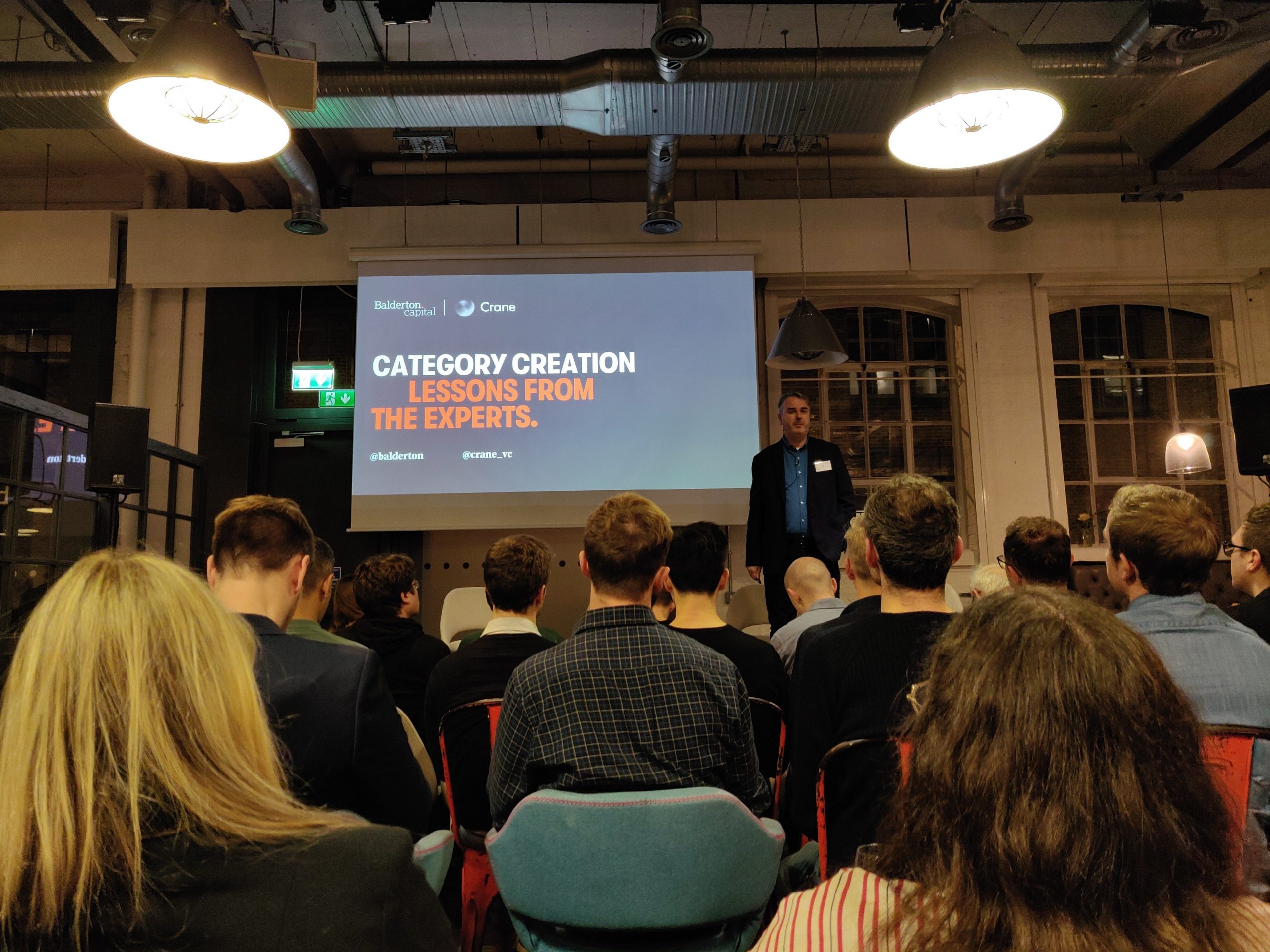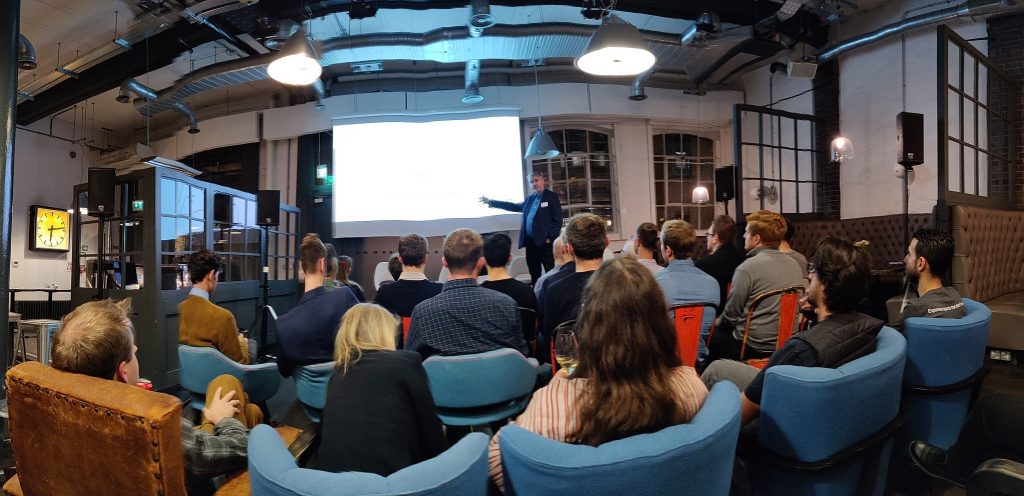Apr 2020
Talking Category Design with Balderton and Crane
Written by Paul Maher

At Positive, talking about Category is what we do.
We often provide strategic Category Design counsel to our clients, many of which are investee companies of well-known venture capital firms. Recently, we partnered up with Balderton Capital and Crane Venture Partners, to speak at a workshop they hosted on Category Design. The workshop, held at Balderton’s Kings Cross offices, discussed the journey from finding product-market fit to Category leadership. The audience was made up some of the greatest early-stage tech founders in the world.
Paul Maher (founder at Categorical and Positive) presented – detailing why startup founders would want to embark on Category creation and provided some tips as to how to go about it. The presentation was followed by a panel of leading SaaS CEOs & executives from Darktrace, Onfido and Tessian.
I was in the audience, listening and taking notes. Speaking to many investee company founders throughout the evening – I’ve taken Paul’s speech, had it transcribed and extracted the main points:

WIFM?
“Three reasons, early stage, you want to attract the best talent and you want to have a distortion of reality that means that your vision is very compelling, more compelling than any of your competitors, and preferably, and we’ll say this again and again, different not better. Have to be different. Better doesn’t count. Why does it not count? Because at the end of the day, someone would be better than your better, and it becomes a race to the bottom.
If you define reality, if you say to Gartner, “Thanks for your 180 magic quadrants. I don’t want to be in your magic quadrant”, you have a shot. So, build a reality distortion field. Commit the team. Something that… in our engagements, and we were consulting this morning with a large FinTech, it has raised 230 million and it’s on its way to its next raise, they have to get their team committed to the Category. If they don’t do it, they’ll get picked off. They know it, we know it. It’s part of the game. So get the team committed to the Category. If you need to, certify them, sit down with your points of view, stick a video camera on them and say, tell me the point of view. Trust me, it works.
Lastly, and most importantly, and the reason that we are in these fantastic surroundings here, is eventually there’s an exit. Okay? At exit, you want the best economics and hopefully, I can prove that you’ll get them with a category. This is my favourite type of market, zero billion dollar market. Nobody in it. Nobody’s to say, you need to be in that magic quadrant, you need to play catch up”.
Think Taxonomy
“Taxonomy. One of the things about a category and how you make it sound different is literally making it sound different. Right? Have your own words that you can imbue with meaning that means something that’s very relevant to the category and maybe not relevant to any of your competitors. We do this all the time. We have a separate taxonomy. I think we created two brand new terms in the payment space this morning for our client, and that’s basically how you do this. You don’t want 20. They’ve got to be concise, but build that taxonomy and stick it in your PowerPoint”.
Eliminate Zeds
“Zeds, an important concept from the book. I think that’s because Americans say Z’s differently to how we say zeds. So they think we’re sort of weird for saying zeds, but in any case, in the book Play Bigger, zeds are really negative, sort of looking at the ground, life’s really hard, another day at the office type people. Okay. Zeds exist in every business. I know. I’ve run a few. The zeds will hide and they’ll hide till the very last minute. A typical time when a zed comes out in a category engagement is just ahead of strike. And I’ve seen this a million times. So typically, let’s say the sales guys are the zeds. They will go along with the marketing bullshit all the way through category until it comes to strike.
And then when they realize and they’ve been educated, that strike’s going to happen, no question, the CEO’s bought in, all of that selling to their friends stuff may need to stop. That’s when they panic, and they’ll lay down an ultimatum. I’ve seen this one happen, which is, “We can’t sell this shit.” Well if you can’t sell this shit, you’re not on board with the category. You’ve got to expect them to come, find them out, ship them out”.
STRIKE!
“Finally, strike. The most important thing about a category, because we’re not just doing this for hypotheticals, we’re doing it for real. We want this to have a needle-changing momentum for the business. So set an aggressive strike goal and do not let that waiver. The typical problem here, products, engineers. Why? They don’t like to be told there’s a deadline that really means something.
So I’ve seen this one as well where it’s like, strike one. And by the way, at Mercury, we did like 11 strikes before we got bought for that big multiple. Just before we’re going to do our second strike, the product team rock up with, “We can’t hit the deadline.” So respect to the CEO, he said, “You can’t make the deadline. We’ll go without you. We’ll do a strike that doesn’t involve any new products at all that just involves some announcements we’re going make about services, some new ways we’re going to market. Tough shit. You’ve missed it.” Guess what happened next time we had a strike. They were begging us three months from strike, “Can we please get our products in?” And at this point you’re like, you guys going to make it? “Yes, we’ll make it.” So hit the strike. Do it aggressively. Don’t be silly. Make it aggressive and you’ll succeed.
And at that point, ladies and gentlemen, that’s all I have for you right now. Thanks”.






